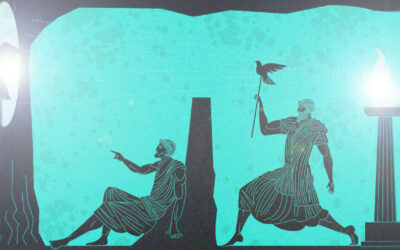This article, written by Antonie Peppler, the inventor of Creative Homeopathy, elaborates on the psychological meaning of Bryonia alba regarding the imprint of “holding onto norms and traditions.” Further, Antonie talks about the signature of this homeopathic remedy based on wild hopes and describes a case study regarding appendicitis.
Bryonia alba – Wild Hops
Holding onto norms and traditions
Bryonia is a perennial herb with its turnipy, large, white, fleshy root and its meter-long, brushy, branched stem and climbs with the help of simple tendrils. The leaves are short-stemmed, wide, cordate, five-parted, dentate, and scabrous. The flowers (June/July) are greenish-white and dioecious. The male comes in long-stemmed clusters, and the female in short-stemmed bundles.
The fruit is a cherry-red little berry. This plant can be found climbing on fences, hedges, and bushes in the Mediterranean to sub-Atlantic climates and is widespread in our country in primarily southern and western Germany.
The fresh root is used for the preparation of the homeopathic remedy. It is somewhat milky, smells unpleasant, and has a bitter, scratchy taste. The mother tincture is yellow to yellow-brown and has an unusual smell and bitter taste.
The Symbology of Bryonia alba
The root of a plant symbolizes the personality of a person. The part of the plant visible above the earth refers to the external visual presentation of the character.
Now, if a plant’s root has a turnipy shape, this points to an undeveloped, unstable personality who still carries enormous potential for development within himself. The bitter taste of the root hints at the embitterment or frustration of the personality that needs Bryonia as a remedy.
Above the earth, the Bryonia plant pulls itself upwards. It must have something to hold onto, something must give it its stability and security so that it can grow. Similarly, the Bryonia personality must hold onto something, for example, to the “should-do”s of society or respectable traditions, in whose context and only in which context will it unfold its development.
The stem covered with bristles symbolizes cantankerousness and the rejection of others who are at the same time needed for stability.
The Bryonia Personality
The signature of this plant describes a personality that has not yet wanted to or been able to develop itself as an individual, that needs an external framework to exist and security measures to grow. On the other hand, these security measures are rejected to the point of bitterness. Naturally, they can also hinder personal development.
The personality is not yet so far in development that personal goals have much meaning. The inner voice is not yet perceived so that its support from the surroundings is not in danger.
Case Study regarding Appendicitis
A typical illness that calls for Bryonia as a homeopathic remedy is appendicitis. Most of the time, this becomes acute when the personality no longer wants to let itself be pressed into its rigid framework. This can be triggered, for example, by a disagreeable teacher at school. One of the most significant Bryonia experiences I have encountered happened during a wedding: the bride’s sister had to be delivered to the hospital with acute appendicitis. Unfortunately, a homeopathic remedy at hand would have made this step unnecessary.
Let’s take a closer look: apparently, the bride’s sister felt that the marriage, along with its associated traditional rights and duties, threatened her sister, which she then projected upon herself. She declared with her illness that, in any case, she would not follow the marriage game rules of her parents, for her security and closeness were not as important as the desire for personal freedom.
Traditional Role-Play
She expected to see in her sister’s marriage the same role–play, confinement, and conformity that her parents had modeled. Even though she was not directly involved in the wedding – after all, it was “only” her sister getting married – she was so intensely occupied with this issue that she produced the corresponding physical symptoms as though it were her wedding.
Another ailment typical for Bryonia is pneumonia. Pneumonia stands symbolically for exchange and communication within a group. The inflammation symbolizes anger and, suppressed aggression, rage. If a personality feels confined by the group, if it is determined by others or through rituals, pneumonia can develop if the character does not consciously oppose the confinement.
Further important symptoms of Bryonia are, for example:
- With aggravation through movement, the personality doesn’t dare to undertake any dynamic activity on its own, or it seems this is forbidden.
- Holding the head with the hands during cough, the personality wants the recognition of others but doesn’t trust them and tries to maintain control over its thoughts.
- The amelioration of symptoms through pressure shows that it doesn’t want to make decisions alone and thinks it needs the “pressure” from others as support.
- With picking of the lips, the personality would dearly like to express criticism but doesn’t dare to.
- With having hunger, but not knowing what and refusing the foods offered, we see that it has not understood what it wants for itself or does not stand up to its own needs.
- With doesn’t want to be disturbed when doing something, the personality demonstrates that it is afraid of being so strongly dominated by its surroundings when acting that it will not be able to follow its own will.
- With skin rashes that evolve slowly, it trusts itself only faint-heartedly to show its old wounds.
Bryonia, as a homeopathic remedy, will help a person to be able to develop his personality. He will better represent his standpoint against the general view of things.














Edit ideas:
-1st Paragraph, last sentence at top “based on wild hopes” Should hopes=hops?
-3rd paragraph under “The Symbology of Bryonia Alba” — “should-do”s –> “should-do’s”
-The text format of the listing of symptoms and their interpretations at the end of the article is inconsistent throughout the list.
Great article! Thanks